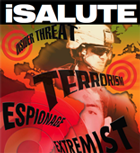Fort Detrick
Sergeant Audie Murphy Club
Command Sergeant Major
810 Schreider Street
Fort Detrick, Maryland 21702-5000
301-619-7620
DSN 343-7620

SGT Audie Murphy

Audie Leon Murphy, son of poor Texas sharecroppers, rose to national fame as the most decorated U.S. combat soldier of World War II. Among his 33 awards and decorations was the Medal of Honor, the highest military award for bravery that can be given to any individual in the United States of America, for "conspicuous gallantry and intrepidity at the risk of his life above and beyond the call of duty." He also received every decoration for valor that his country had to offer, some of them more than once, including 5 decorations by France and Belgium. Credited with either killing over 240 of the enemy while wounding and capturing many others, he became a legend within the 3rd Infantry Division. Beginning his service as an Army Private, Audie quickly rose to the enlisted rank of Staff Sergeant, was given a "battle field" commission as 2nd Lieutenant, was wounded three times, fought in 9 major campaigns across the European Theater, and survived the war.
During Murphy's 3 years active service as a combat soldier in World War II, Audie became one of the best fighting combat soldiers of this or any other century. What Audie accomplished during this period is most significant and probably will never be repeated by another soldier, given today's high-tech type of warfare. The U.S. Army has always declared that there will never be another Audie Murphy.
On 21 September, 1945, Audie was released from the Army as an active member and reassigned to inactive status. During this same time, actor James Cagney invited Murphy to Hollywood in September 1945, when he saw Murphy's photo on the cover of Life Magazine. The next couple of years in California were hard times for Audie Murphy. Struggling and becoming disillusioned from lack of work while sleeping in a local gymnasium, he finally received token acting parts in his first two films.

His first starring role came in a 1949 released film by Allied Artists called, Bad Boy. In 1950 Murphy eventually got a contract with Universal-International (later called Universal) where he starred in 26 films, 23 of them westerns over the next 15 years. His 1949 autobiography To Hell And Back was a best seller. Murphy starred as himself in a film biography released by Universal-International in 1955 with the same title. The movie, To Hell and Back, held the record as Universal's highest grossing picture until 1975 when it was finally surpassed by the movie Jaws. In the mid-60s the studios switched from contract players to hiring actors on a picture-by-picture basis. Consequently, when his contract expired in 1965 Universal did not renew. This gave him the opportunity to work with other studios and independent film producers. In the 25 years that Audie spent in Hollywood, he made a total of 44 feature films.

Audie Murphy wrote some poetry and was quite successful as a songwriter. He usually teamed up with talented artists and composers such as Guy Mitchell, Jimmy Bryant, Scott Turner, Coy Ziegler, or Terri Eddleman. Dozens of Audie Murphy's songs were recorded and released by such great performers as Dean Martin, Eddy Arnold, Charley Pride, Jimmy Bryant, Porter Waggoner, Jerry Wallace, Roy Clark, Harry Nilsson and many, many others. His two biggest hits were Shutters and Boards and When the Wind Blows in Chicago. Eddy Arnold recorded When the Wind Blows in Chicago for his 1993 album Last of the Love Song Singers which is currently in release by RCA.
Audie suffered from what is now known as Post Traumatic Stress Disorder (PTSD) and was plagued by insomnia and depression. During the mid-60's he became dependent for a time on doctor prescribed sleeping pills called Placidly. When he recognized that he had become addicted to this prescription drug, he locked himself in a motel room, stopped taking the sleeping pills and went through withdrawal symptoms for a week. Always an advocate for the needs of veterans, he broke the taboo about discussing war related mental problems after this experience. In an effort to draw attention to the problems of returning Korean and Vietnam War veterans, Audie Murphy spoke-out candidly about his personal problems with PTSD, then known as "Battle Fatigue". He publicly called for the United States government to give more consideration and study to the emotional impact war has on veterans and to extend health care benefits to address PTSD and other mental health problems of returning war vets.
While on a business trip on May 28, 1971, (Memorial Day Weekend) he was killed at the age of 46. A private plane flying in fog and rain crashed in the side of a mountain near Roanoke, Virginia. Five others including the pilot were also killed. Although Audie owned and flew his own plane earlier in his career at Hollywood, he was among the passengers that tragic day.
On June 7th, Audie Murphy was buried with full military honors in Arlington National Cemetery. His gravesite, near the Amphitheater, is the second most visited gravesite year round. President Kennedy's grave is the most visited.
In 1996 the Texas Legislature officially designated his birthday, June 20th, as Audie Murphy Day. On June 9, 1999 Governor George W. Bush, Texas made a similar proclamation declaring June 20th to officially be Audie Murphy Day in the state of Texas.
The History of the Sergeant Audie Murphy Club

The original club was started at Fort Hood, Texas early in 1986. There were several key people at Fort Hood - officer, enlisted, civil service, and a Killeen civilian - who were instrumental in getting this club up and running.
Leading the effort was Lieutenant General Crosbie Saint, then the III Corps commander; his Command Sergeant Major George L. Horvath; III Corps Awards Clerk Jean Crisp, who is now Test and Experimentation Command (TEXCOM) awards clerk, and Don Moore, a Killeen artist who assisted with designing the logo and club awards. In 1991, then III Corps Commander Lieutenant General Pete Taylor and Command Sergeant Major Richard B. Cayton expanded the Fort Hood installation club to include all of III Corps. This included Fort Riley, Kansas; Fort Sill, Oklahoma; Fort Bliss, Texas; Fort Polk, Louisiana; and Fort Carson, Colorado.
In 1993, CSM Cayton was voted into the Sergeant Audie Murphy Club by the membership and then became the Forces Command Sergeant Major. Soon thereafter, the club became Forces-Command (FORSCOM) wide, including the Reserves and National Guard.
In 1994 at a Sergeant Major of the Army conference, the Sergeant Audie Murphy Club spread Army-wide, to all commands with installations retaining the selection process for their own NCOs. In 1998, it was estimated that the club membership was over 3000 soldiers and was steadilly increasing.
SAMC Crest

S*A*M*C: Initials separated by three stars which represent the Be, Know, and Do for the NCO.
SSG Rank Insignia: Reflects Audie Murphy's highest enlisted rank.
The Eagle: Our national bird and symbol of freedom, the intent of the club to be nationwide.
The Laurel: Represents the individual achievement of the NCOs in the club.
The Lightning Bolt: Represents swift and decisive action taken by the NCO.
The Sword: A historical reference, a tool for the NCO to cut to the heart of the matter, to lead the charge.
The Streamers: Indicate upon which we base our philosophy-Loyalty, Discipline, Professionalism, and Caring.





